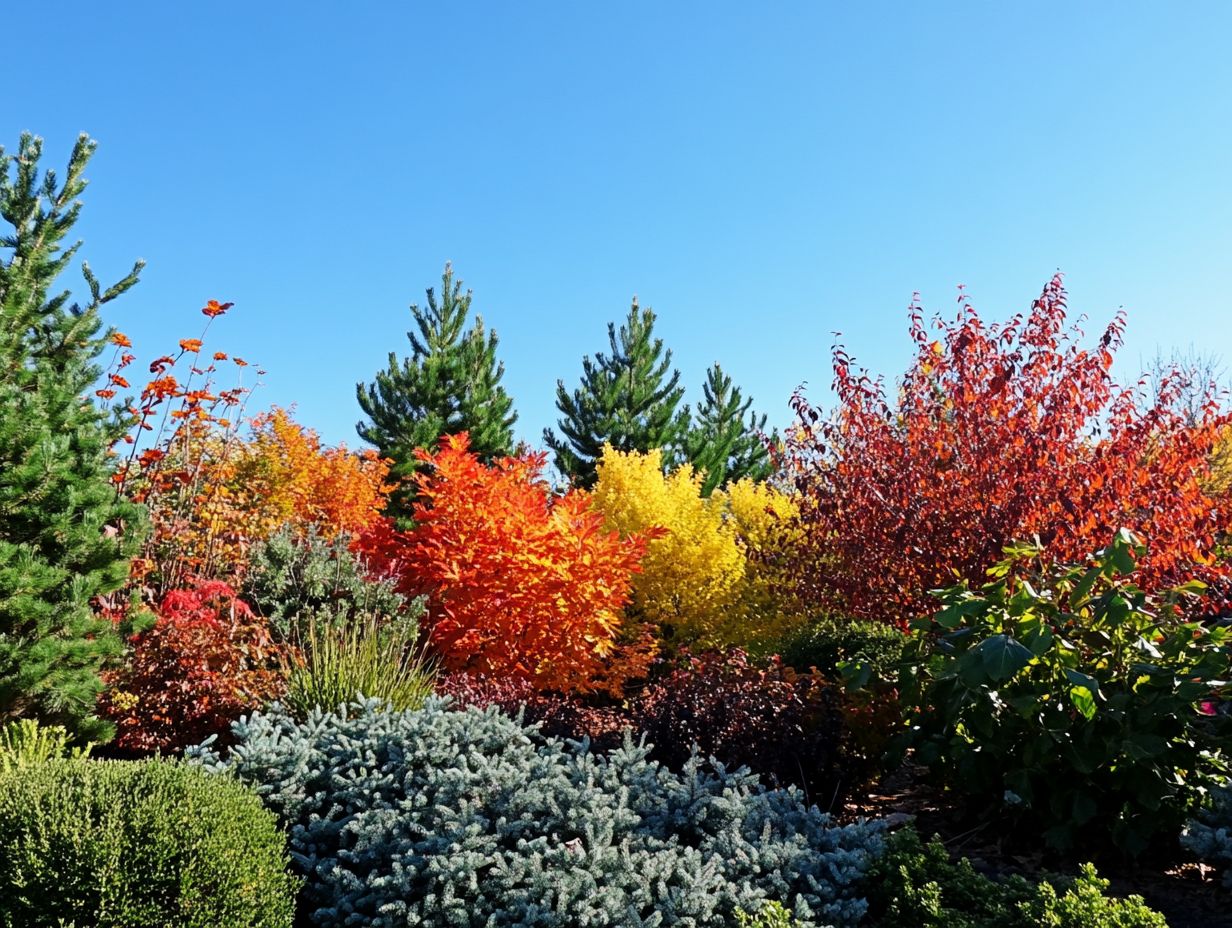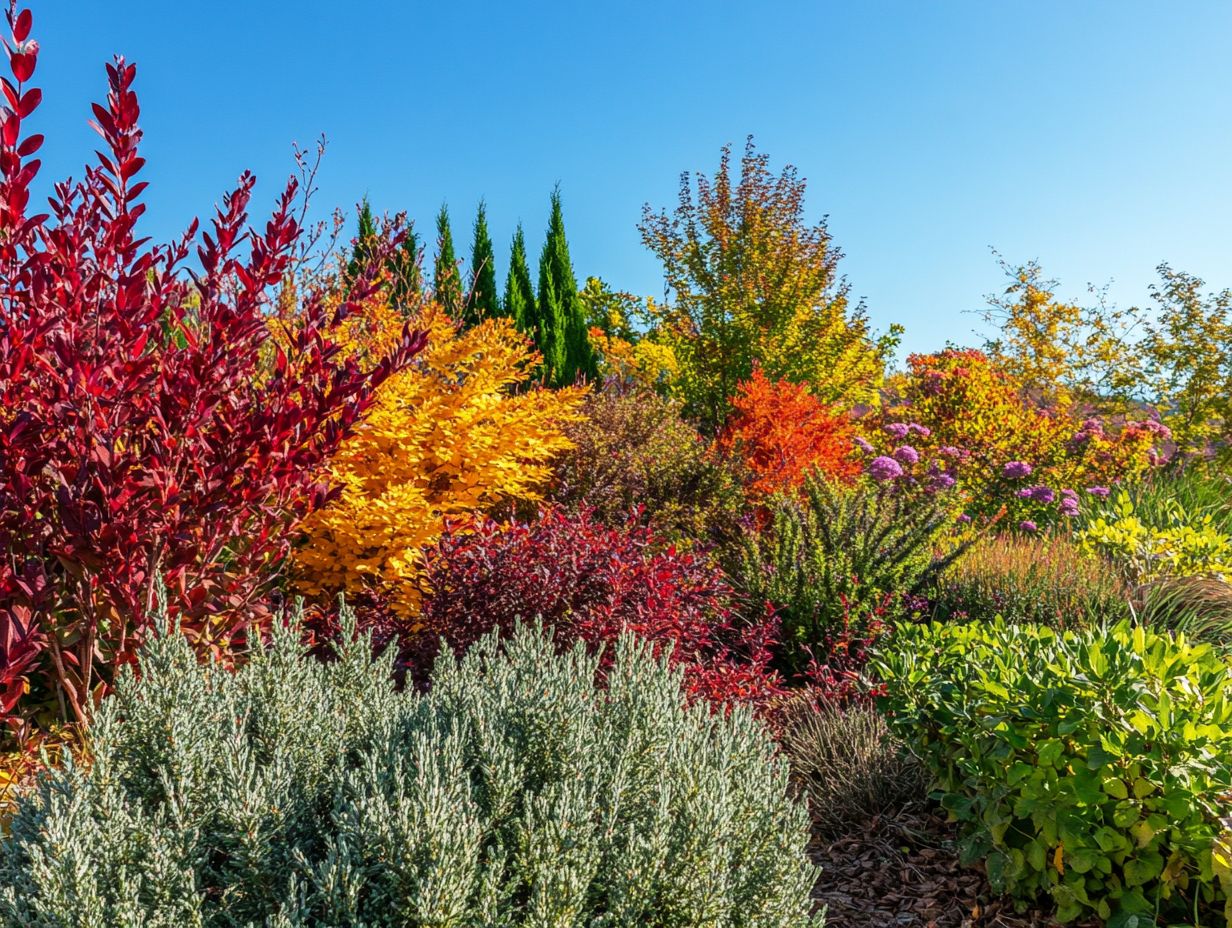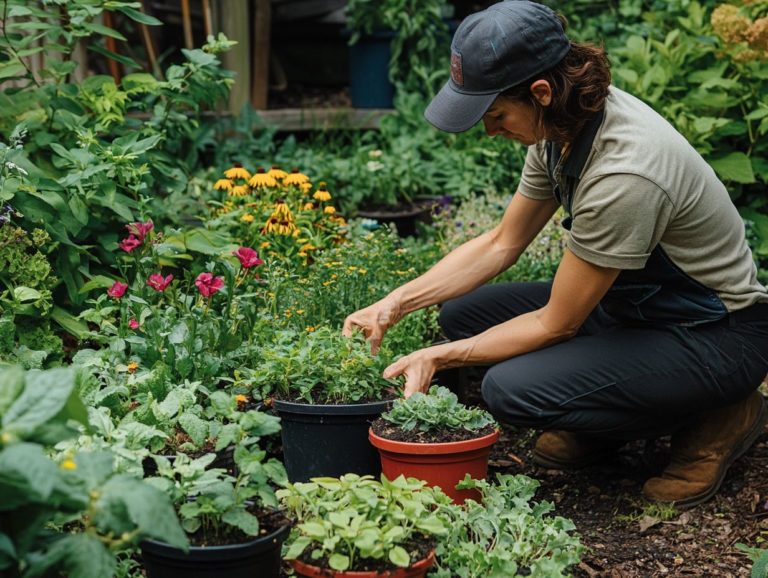Top 10 Plants for Fall Color in Cold Climates
As the crisp air of autumn envelops you, the landscape morphs into a vibrant tapestry of reds, oranges, and yellows.
For those residing in colder climates, choosing the right plants is vital to keep your gardens a feast for the eyes, even as the temperatures dip.
Get ready to explore the top 10 plants that will transform your garden into a fall wonderland, paired with essential tips on maintenance, landscape design integration, and potential drawbacks.
Discover how to fully embrace the autumn season with these exquisite selections!
Contents
- Key Takeaways:
- 1. Maple Trees
- 2. Burning Bush
- 3. Witch Hazel
- 4. Red Twig Dogwood
- 5. Oak Trees
- 6. Virginia Sweetspire
- 7. Purple Beautyberry
- 8. Red Chokeberry
- 9. Redbud Trees
- 10. Virginia Creeper
- What Makes These Plants Ideal for Fall Color in Cold Climates?
- What Other Factors Should Be Considered When Choosing Fall Plants?
- How Can These Plants Be Incorporated into a Landscape Design?
- What Are the Maintenance Requirements for These Plants?
- Are There Any Potential Drawbacks to These Plants?
- What Are Some Other Recommended Plants for Fall Color in Cold Climates?
- Frequently Asked Questions
- What are the top 10 plants for fall color in cold climates?
- How do I choose the best plants for fall color in cold climates?
- Can I plant these top 10 fall color plants in any type of soil?
- Do these plants require a lot of maintenance?
- Can I grow these plants in containers?
- Do these plants attract any wildlife?
Key Takeaways:

- Maple trees are a classic choice for fall color in cold climates, with their vibrant red, orange, and yellow leaves.
- Witch hazel offers unique yellow and orange flowers that bloom in the fall, adding a pop of color to any landscape.
- To maximize fall color, consider incorporating multiple plants with varying hues and textures, such as red chokeberry and purple beautyberry.
1. Maple Trees
You ll find that maple trees, especially the October Glory Red Maple, are nothing short of iconic when it comes to vibrant fall foliage. They effortlessly become the centerpiece of seasonal gardening, making them an essential choice for elevating autumn landscapes.
The bright colors make the garden look beautiful and provide a stunning backdrop for a variety of blooming fall flowers, creating a picturesque scene that beckons both the eye and local pollinators.
Among the plethora of maple species, each one boasts its own unique charm. Take the delicate, lobed leaves of the Sugar Maple, for example. Or consider the robust, rounded foliage of the Silver Maple.
The October Glory truly stands out for its eye-catching ruby-red leaves that emerge in late fall, along with its resilient nature. It’s a go-to for gardeners who desire a tough yet beautiful addition to their landscapes.
As these trees shed their leaves, they weave a rich tapestry of colors that serves as vital habitat for various pollinators, who depend on the late-blooming flowers for nourishment and shelter. This ecological dance enriches the autumn scene, highlighting the dual importance of maple trees in enhancing visual beauty while providing crucial environmental support.
2. Burning Bush
The Burning Bush is renowned for its striking red foliage in the fall, bringing a dramatic flair to your garden and beautifully complementing other seasonal flowers.
This iconic shrub flourishes in well-drained soil and thrives in full sun to partial shade, making it an adaptable choice for diverse landscapes.
When selecting companions for the Burning Bush, consider pairing it with asters or sedums, which bloom later in the season and create a vibrant tapestry of color.
Its compact growth habit makes it ideal for both formal hedging and casual plantings, ensuring it captures attention in any setting.
This hardy plant can endure colder climates, allowing you to relish its breathtaking transformation year after year.
3. Witch Hazel
Witch Hazel truly stands out with its unique late-blooming flowers, adding a vibrant splash of color to your autumn garden and enriching the seasonal palette.
With its striking, spider-like blooms that range from sunny yellows to deep, fiery oranges, this remarkable shrub not only catches the eye but also plays an essential role in extending your gardening season.
You ll appreciate how Witch Hazel beautifully complements other fall blooms, such as asters and chrysanthemums, weaving a vibrant tapestry of colors and textures throughout your space.
This late-season flowering attracts various pollinators that are still buzzing about. By incorporating Witch Hazel into your landscape, you ensure that the beauty of your garden lingers well into the cooler months, delighting both you and your visitors.
Join the conversation! Share your favorite fall plants in the comments below!
4. Red Twig Dogwood
Red Twig Dogwood boasts striking red stems that create a vibrant contrast against the backdrop of fall flowers. This plant brings a splash of color in autumn and elevates the overall visual dynamics of your garden, drawing attention and sparking interest.
As the leaves transition, those vivid stems emerge, creating a dramatic display that captivates anyone who passes by. Place it in a prominent spot either as a focal point or within a mixed border so that its bright color can truly shine. Pairing Red Twig Dogwood with perennials and ornamental grasses will further enhance its appeal, adding texture and balance to your garden throughout the fall season.
5. Oak Trees
Imagine the grandeur of oak trees. Their majestic stature and vibrant fall colors create an exquisite backdrop for your seasonal gardening endeavors, particularly when paired with an array of fall flowers, such as Japanese Anemone.
These remarkable giants, including the Red Oak, White Oak, and Pin Oak, play a crucial role in the health of their ecosystems. They provide essential habitats for a myriad of wildlife, from birds to insects, while their acorns offer a vital food source during the colder months.
As autumn descends, picture the brilliant shades of orange, red, and yellow from their leaves artfully contrasting with the deep hues of chrysanthemums and asters. This stunning display captivates the eye of the gardener and beckons local fauna to join in the seasonal celebration.
6. Virginia Sweetspire

Virginia Sweetspire is an exceptional choice for your autumn garden. Its fragrant blooms attract buzzing bees and fluttering butterflies, making your garden a lively spot! In fall, its foliage transforms into a rich tapestry of hues, adding a touch of elegance to your landscape.
This plant thrives in spaces that range from partially shaded to full sun. It prefers moist, well-drained soils, giving you the flexibility to place it in various garden settings. Its adaptability makes it a perfect fit for both formal and naturalistic landscapes.
As the weather cools, the vibrant reds and oranges of its leaves create a stunning backdrop. The sweetly scented flowers attract bees and butterflies, infusing your garden with life. By incorporating this striking shrub, you not only enhance seasonal beauty but also support local ecosystems by nurturing these essential pollinators.
7. Purple Beautyberry
Purple Beautyberry is celebrated for its vibrant purple berries that grace your garden in the fall. They add not just a splash of color but also serve as a vital food source for local wildlife.
This striking plant, a favorite in gardens that embrace native flora, captivates with its bold hue while playing a crucial role in supporting local ecosystems. As autumn arrives, those enchanting berries become a feast for a diverse array of birds and mammals, providing essential nutrition when other food sources are scarce.
The presence of Purple Beautyberry fosters a flourishing environment for numerous pollinators, like bees and butterflies, which are irresistibly drawn to its delicate flowers in late summer. By incorporating this stunning shrub into your fall garden, you elevate its visual allure and promote biodiversity, sustaining wildlife through the changing seasons.
8. Red Chokeberry
Red Chokeberry stands out for its striking red berries and exquisite fall foliage. This remarkable shrub enchants with its vibrant colors while offering substantial ecological benefits, attracting a variety of bird species and pollinators to your garden.
As the days shorten and temperatures dip, its glossy leaves transform into a breathtaking array of fiery orange and crimson hues. This captivating visual display beautifully complements other autumn plants, much like the top 5 shade-tolerant plants for cold climates.
By offering food and shelter, this resilient perennial fosters biodiversity, contributing to a flourishing ecosystem amidst the changing seasons. For gardeners like you, who seek both aesthetic charm and environmental advantages, this hardy plant is an invaluable addition to your fall arrangements.
9. Redbud Trees
Redbud trees are a treasure, celebrated for their early spring blossoms and vibrant fall colors. They effortlessly enhance your seasonal garden designs while offering year-round beauty.
These trees lose their leaves in winter and flaunt vibrant clusters of delicate pink flowers that bloom before the leaves unfurl. This creates a breathtaking spectacle that heralds the arrival of warmer months.
As summer unfolds, their lush green foliage provides a calming backdrop. When autumn arrives, they explode into brilliant shades of yellow and orange, delivering a striking contrast that elevates any garden’s aesthetic.
By pairing them with complementary plants like hostas or ferns, you can create a breathtaking visual masterpiece that evolves beautifully through each season.
10. Virginia Creeper
Virginia Creeper is a remarkable vine that adds dramatic fall colors to your landscape, providing a stunning backdrop for seasonal flowers and plants.
This hardy climber thrives in a variety of conditions, effortlessly adapting to both sun and shade and even flourishing in poor soil.
As temperatures cool, its leaves transform from vibrant green to rich shades of red and purple. This crafting a visual spectacle that captivates anyone strolling through your garden.
It also makes a great choice for covering walls, fences, or trellises, offering not just beauty but also a welcoming habitat for wildlife. Incorporating this vine into your landscape can achieve a striking autumnal aesthetic, making your outdoor spaces even more inviting during the cooler months.
What Makes These Plants Ideal for Fall Color in Cold Climates?
Plants that flourish in cold climates, such as the exquisite Japanese Anemone and the vibrant Maximilian Sunflower, infuse your garden with color and resilience. They create breathtaking landscapes even as temperatures begin to drop.
These botanical marvels boast remarkable hardiness, enabling them to endure harsh weather conditions while still enchanting with beautiful blooms. The Japanese Anemone features delicate pastel petals that thrive even as frost approaches, adding a soft charm to your garden’s palette.
The Maximilian Sunflower, with its radiant yellow petals, provides a bright contrast against the rich autumn foliage. These resilient plants often extend their blooming periods well into late fall, ensuring that your garden maintains visual interest long after the traditional growing season ends, thus enhancing the overall aesthetic appeal during the cooler months.
What Other Factors Should Be Considered When Choosing Fall Plants?

When selecting fall plants, it s essential to consider factors like blooming times, hardiness, and the ability to maintain visual interest as temperatures begin to drop.
Along with these foundational elements, pay close attention to the specific growth requirements of each plant, such as sunlight and water needs, and how they will coexist with your existing garden inhabitants. Ensuring that your new additions harmonize with other plants is vital for creating a cohesive aesthetic.
Late-blooming species play an invaluable role in extending your garden’s visual appeal. They offer vibrant colors and textures during the later months of the year. This approach guarantees that your landscape remains lively and inviting even as many other plants start to fade.
Don t wait to add these vibrant plants to your garden this fall!
How Can These Plants Be Incorporated into a Landscape Design?
Incorporating fall plants into your landscape design requires thoughtful planning. This enhances a pleasing look, ensuring that each plant contributes meaningfully to the overall aesthetic and ecological balance.
Consider color schemes to create a vibrant tapestry of reds, oranges, and yellows that brighten your landscape as the days grow shorter. The height of each plant plays a crucial role. Taller specimens act as backdrops for shorter varieties, drawing the eye upwards and adding layers to your garden’s composition.
Transitioning from summer blooms to fall flowers means selecting species that thrive in cooler temperatures and provide continuity in your landscape. By embedding these design principles, your fall garden evolves beautifully, capturing seasonal charm while supporting animals and insects native to your area.
What Are the Maintenance Requirements for These Plants?
Proper maintenance is essential for ensuring that your fall plants, such as the resilient Helenium (a colorful flower that blooms in late summer) and Black-Eyed Susan, thrive and continue to provide vibrant displays throughout the season.
To maximize their visual impact, pay attention to the specific care requirements that set each type of flower apart. These plants benefit from a well-balanced watering schedule; deep watering once a week is ideal, especially during dry spells. Pruning spent flowers enhances their appearance and encourages new growth, effectively extending the blooming period.
As temperatures dip, prepare these plants for the changing season with a layer of mulch to retain moisture and regulate soil temperature, allowing them to flourish well into autumn.
Are There Any Potential Drawbacks to These Plants?
While many fall flowers offer breathtaking visuals, it’s essential to weigh potential drawbacks, such as invasiveness or specific environmental needs that may not align with every garden’s conditions.
For example, Aster and Goldenrod certain varieties can spread aggressively if left unchecked, while others might demand well-drained soil or particular light exposure that not every gardener can easily provide. To tackle these challenges, conduct thorough research before planting.
Consider utilizing barriers for invasive species or amending the soil to meet the specific requirements of your chosen plants.
By implementing these strategies, you can elevate the allure of your fall garden while ensuring the long-term health and sustainability of your floral selections.
What Are Some Other Recommended Plants for Fall Color in Cold Climates?
Along with well-known species like the Japanese Anemone and Monkshood, several other exceptional plants for small cold-climate balconies can elevate fall color in cold climates, creating a striking seasonal palette.
Take the ‘Autumn Blaze’ maple; its fiery hues set your garden aglow with stunning foliage. Then there’s the elegant miscanthus, an ornamental grass that adds graceful contrast as it sways in the crisp autumn breeze. The ‘Twilight’ sweetgum dazzles with a burst of reds, yellows, and purples, offering a dynamic choice for landscape diversity. Sedum, with its late blooming period, not only attracts pollinators but also offers robust, colorful foliage that endures throughout the season.
These selections not only thrive in cold temperatures but also bring unique visual interest making them fantastic additions to your fall garden!
Frequently Asked Questions
What are the top 10 plants for fall color in cold climates?

The top 10 plants for fall color in cold climates include red maple, sugar maple, Japanese maple, burning bush, dogwood, witch hazel, sumac, viburnum, oakleaf hydrangea, and colorful shrubs for cold climates like serviceberry.
How do I choose the best plants for fall color in cold climates?
When selecting plants for fall color in cold climates, look for those with vibrant red, orange, and yellow foliage. Additionally, consider the hardiness of the plant and its ability to withstand freezing temperatures. For great options, check out the top 5 shrubs for cold-climate gardens.
Ready to start your own fall garden? Research specific plants that interest you and enjoy the seasonal beauty!
Can I plant these top 10 fall color plants in any type of soil?
These plants thrive in soil that drains well and is a little acidic. Always check the specific needs for each plant before planting.
Do these plants require a lot of maintenance?
Most are low-maintenance. Regular watering and occasional pruning will keep them looking great.
Can I grow these plants in containers?
Yes, many of these plants can flourish in containers. Just ensure they have enough root space and good drainage.
Do these plants attract any wildlife?
Some, like dogwood and serviceberry, produce berries that attract birds and other wildlife in the fall. This adds vibrant life to your garden!






